ENTR101: Entrepreneurial Profile Analysis and Opportunity Recognition
VerifiedAdded on 2022/12/28
|9
|1992
|71
Report
AI Summary
This report provides a critical analysis of entrepreneurial profiles, focusing on four key dimensions: opportunity orientation, persistent problem-solving, feedback seeking, and internal locus of control. It examines the strengths and weaknesses of each dimension and maps them onto the Entrepreneurial Opportunity Recognition Process Model, which includes the stages of discover, generate, and recognize. The report offers recommendations for improving weaknesses, such as emphasizing data analysis over gut feelings, focusing on identifying opportunities, and seeking feedback from trusted sources. The analysis aims to enhance the understanding of entrepreneurial mindsets and their impact on the business implementation process, ultimately determining the feasibility of new business ideas. The report concludes with a summary of the key findings and their implications for aspiring entrepreneurs. The report is based on the assignment brief provided and includes an executive summary, introduction, main body, recommendations, conclusion, and references. The assignment is contributed by a student to be published on the website Desklib. Desklib is a platform which provides all the necessary AI based study tools for students.
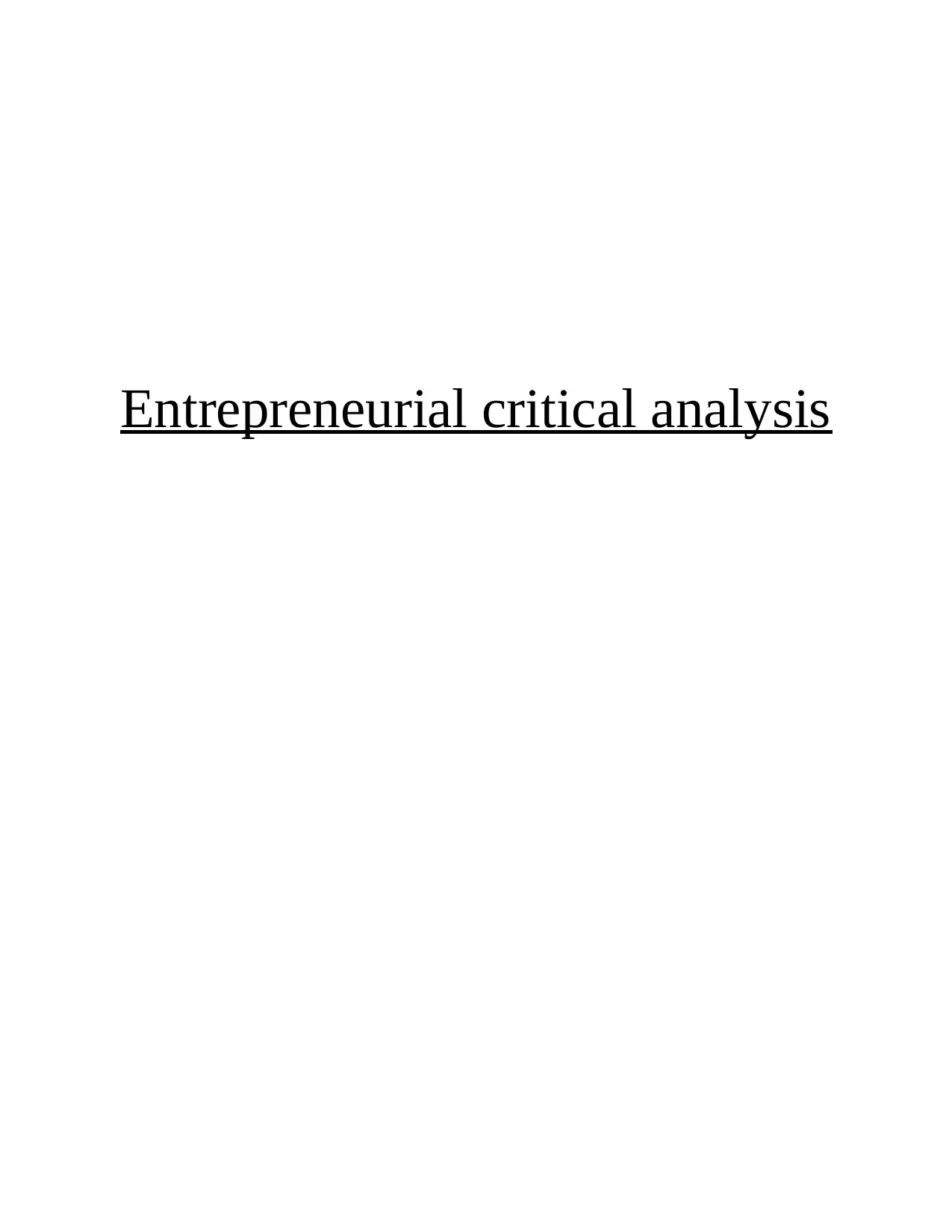
Entrepreneurial critical analysis
Paraphrase This Document
Need a fresh take? Get an instant paraphrase of this document with our AI Paraphraser
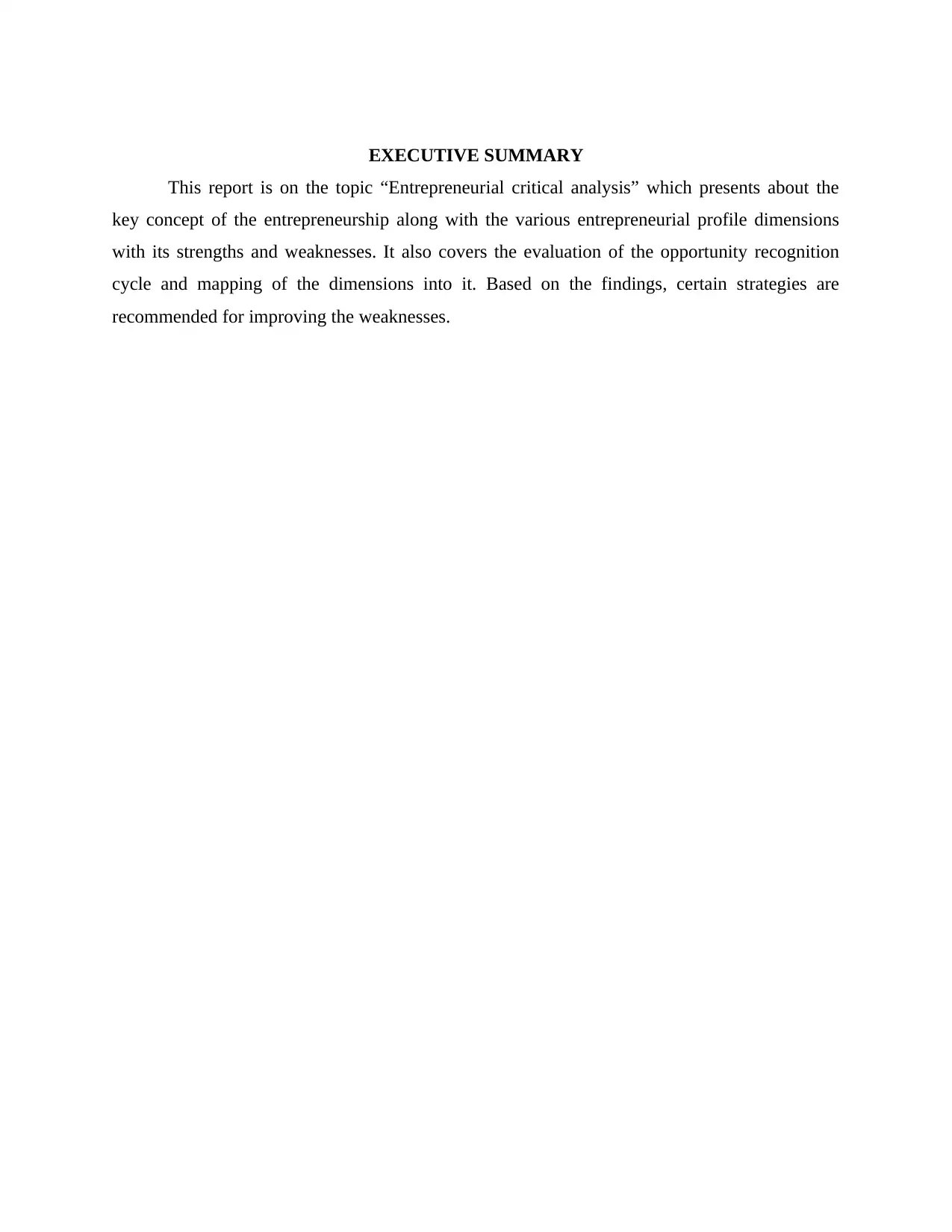
EXECUTIVE SUMMARY
This report is on the topic “Entrepreneurial critical analysis” which presents about the
key concept of the entrepreneurship along with the various entrepreneurial profile dimensions
with its strengths and weaknesses. It also covers the evaluation of the opportunity recognition
cycle and mapping of the dimensions into it. Based on the findings, certain strategies are
recommended for improving the weaknesses.
This report is on the topic “Entrepreneurial critical analysis” which presents about the
key concept of the entrepreneurship along with the various entrepreneurial profile dimensions
with its strengths and weaknesses. It also covers the evaluation of the opportunity recognition
cycle and mapping of the dimensions into it. Based on the findings, certain strategies are
recommended for improving the weaknesses.
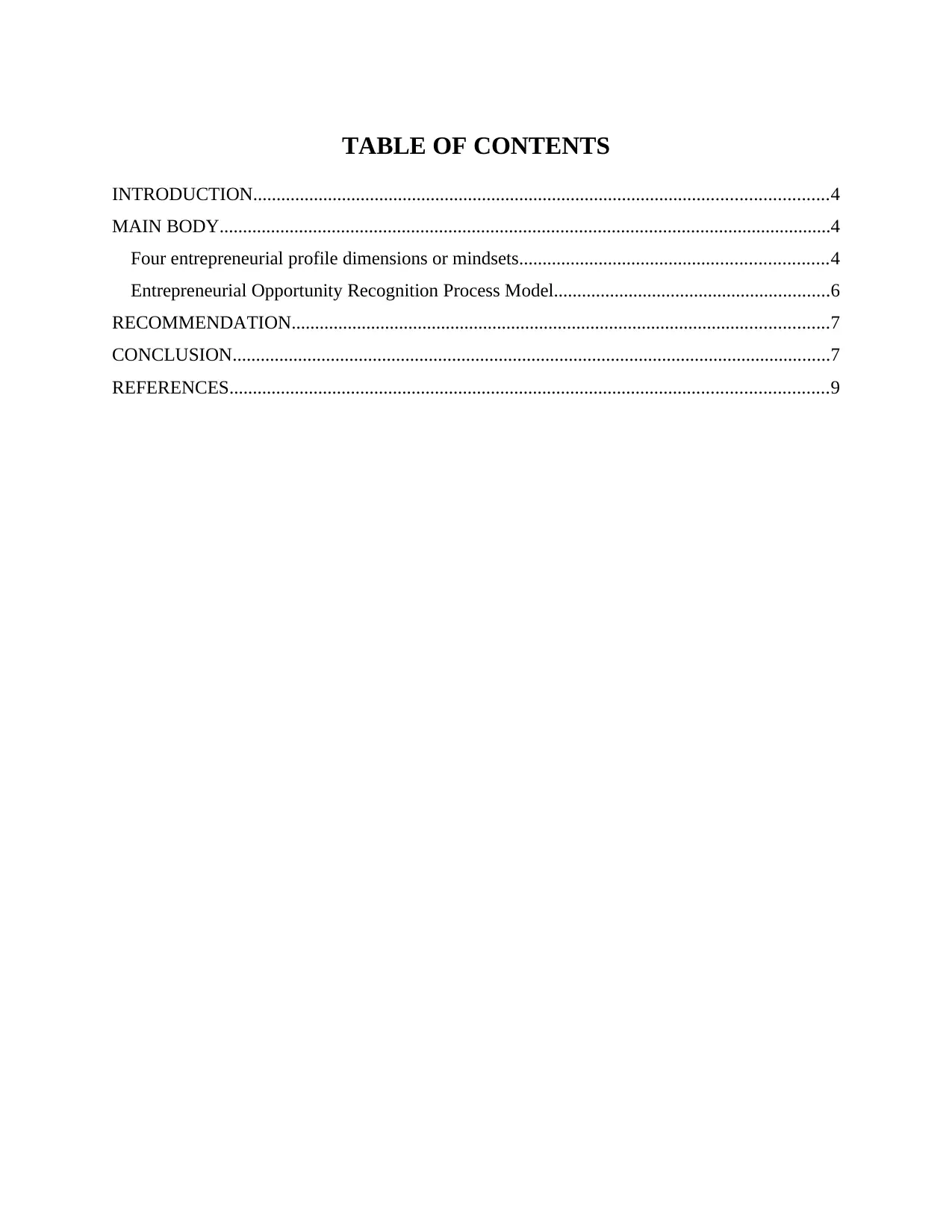
TABLE OF CONTENTS
INTRODUCTION...........................................................................................................................4
MAIN BODY...................................................................................................................................4
Four entrepreneurial profile dimensions or mindsets..................................................................4
Entrepreneurial Opportunity Recognition Process Model...........................................................6
RECOMMENDATION...................................................................................................................7
CONCLUSION................................................................................................................................7
REFERENCES................................................................................................................................9
INTRODUCTION...........................................................................................................................4
MAIN BODY...................................................................................................................................4
Four entrepreneurial profile dimensions or mindsets..................................................................4
Entrepreneurial Opportunity Recognition Process Model...........................................................6
RECOMMENDATION...................................................................................................................7
CONCLUSION................................................................................................................................7
REFERENCES................................................................................................................................9
⊘ This is a preview!⊘
Do you want full access?
Subscribe today to unlock all pages.

Trusted by 1+ million students worldwide

INTRODUCTION
Entrepreneurship basically refers to the ability and the readiness of the person to develop,
organize and carry out the business in combination with the various uncertainties with the aim of
making profits. In simple terms, it refers to the willingness to initiate a new business. It plays an
important role in the economic development and expanding the marketplace. My entrepreneurial
journey started by being stuck with the idea of offering large scale digital marketing services in a
personalized way which will help in effectively meeting up the changing the market scenario.
With this idea in mind, proper evaluation of it was done and finding the appropriate market and
target clients. This journey has helped me in sharpening my skills and gaining greater insight in
the business.
MAIN BODY
Entrepreneurial profile dimensions or mindsets
For the purpose of successfully accomplishing the new business idea the four
entrepreneurial dimensions are identified which are described below.
Opportunity orientation
This profile dimension refers to the seeing the world full of opportunities and how one
can create or access that opportunities along with the learning which will turn out the challenges
and the failures into the possibilities and the opportunities which results into leading the change
as a change maker (Wardana and et.al, 2020). In respect to the entrepreneurial journey following
were the strength and weaknesses of the dimensions.
Strengths:
Under this each event is considered to be a business opportunity, ideas are generated
constantly pertaining to the different aspects like the efficiency, skills of people and the potential
new businesses.
Weaknesses:
It is mostly relied on the gut feelings as the entrepreneurs mainly undertake decisions
based on feelings rather than on the conscious analysis of the situation. It incorporates high
analytical data but the actual decision is based upon the feelings. This might turn into incurring
huge losses.
Persistent problem solving
Entrepreneurship basically refers to the ability and the readiness of the person to develop,
organize and carry out the business in combination with the various uncertainties with the aim of
making profits. In simple terms, it refers to the willingness to initiate a new business. It plays an
important role in the economic development and expanding the marketplace. My entrepreneurial
journey started by being stuck with the idea of offering large scale digital marketing services in a
personalized way which will help in effectively meeting up the changing the market scenario.
With this idea in mind, proper evaluation of it was done and finding the appropriate market and
target clients. This journey has helped me in sharpening my skills and gaining greater insight in
the business.
MAIN BODY
Entrepreneurial profile dimensions or mindsets
For the purpose of successfully accomplishing the new business idea the four
entrepreneurial dimensions are identified which are described below.
Opportunity orientation
This profile dimension refers to the seeing the world full of opportunities and how one
can create or access that opportunities along with the learning which will turn out the challenges
and the failures into the possibilities and the opportunities which results into leading the change
as a change maker (Wardana and et.al, 2020). In respect to the entrepreneurial journey following
were the strength and weaknesses of the dimensions.
Strengths:
Under this each event is considered to be a business opportunity, ideas are generated
constantly pertaining to the different aspects like the efficiency, skills of people and the potential
new businesses.
Weaknesses:
It is mostly relied on the gut feelings as the entrepreneurs mainly undertake decisions
based on feelings rather than on the conscious analysis of the situation. It incorporates high
analytical data but the actual decision is based upon the feelings. This might turn into incurring
huge losses.
Persistent problem solving
Paraphrase This Document
Need a fresh take? Get an instant paraphrase of this document with our AI Paraphraser
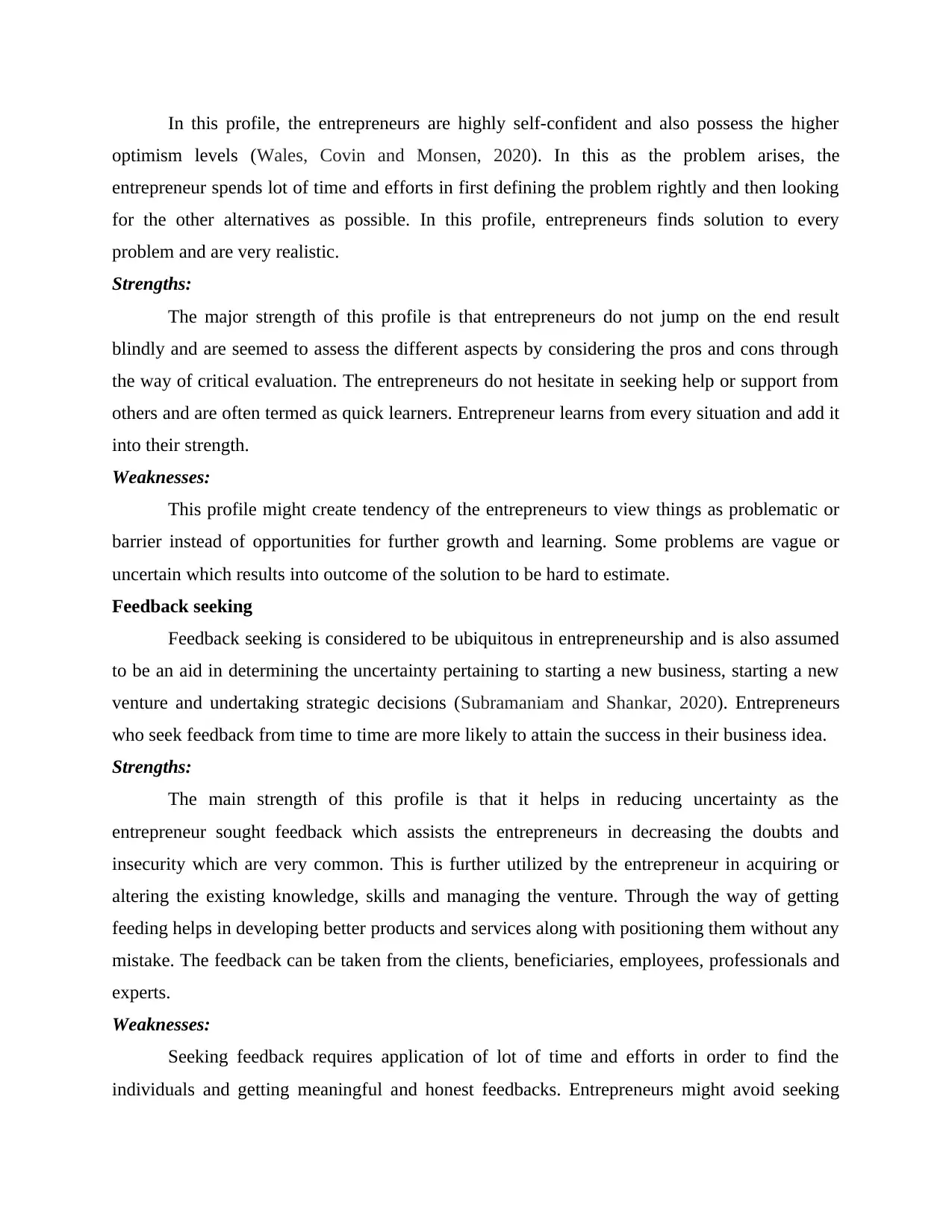
In this profile, the entrepreneurs are highly self-confident and also possess the higher
optimism levels (Wales, Covin and Monsen, 2020). In this as the problem arises, the
entrepreneur spends lot of time and efforts in first defining the problem rightly and then looking
for the other alternatives as possible. In this profile, entrepreneurs finds solution to every
problem and are very realistic.
Strengths:
The major strength of this profile is that entrepreneurs do not jump on the end result
blindly and are seemed to assess the different aspects by considering the pros and cons through
the way of critical evaluation. The entrepreneurs do not hesitate in seeking help or support from
others and are often termed as quick learners. Entrepreneur learns from every situation and add it
into their strength.
Weaknesses:
This profile might create tendency of the entrepreneurs to view things as problematic or
barrier instead of opportunities for further growth and learning. Some problems are vague or
uncertain which results into outcome of the solution to be hard to estimate.
Feedback seeking
Feedback seeking is considered to be ubiquitous in entrepreneurship and is also assumed
to be an aid in determining the uncertainty pertaining to starting a new business, starting a new
venture and undertaking strategic decisions (Subramaniam and Shankar, 2020). Entrepreneurs
who seek feedback from time to time are more likely to attain the success in their business idea.
Strengths:
The main strength of this profile is that it helps in reducing uncertainty as the
entrepreneur sought feedback which assists the entrepreneurs in decreasing the doubts and
insecurity which are very common. This is further utilized by the entrepreneur in acquiring or
altering the existing knowledge, skills and managing the venture. Through the way of getting
feeding helps in developing better products and services along with positioning them without any
mistake. The feedback can be taken from the clients, beneficiaries, employees, professionals and
experts.
Weaknesses:
Seeking feedback requires application of lot of time and efforts in order to find the
individuals and getting meaningful and honest feedbacks. Entrepreneurs might avoid seeking
optimism levels (Wales, Covin and Monsen, 2020). In this as the problem arises, the
entrepreneur spends lot of time and efforts in first defining the problem rightly and then looking
for the other alternatives as possible. In this profile, entrepreneurs finds solution to every
problem and are very realistic.
Strengths:
The major strength of this profile is that entrepreneurs do not jump on the end result
blindly and are seemed to assess the different aspects by considering the pros and cons through
the way of critical evaluation. The entrepreneurs do not hesitate in seeking help or support from
others and are often termed as quick learners. Entrepreneur learns from every situation and add it
into their strength.
Weaknesses:
This profile might create tendency of the entrepreneurs to view things as problematic or
barrier instead of opportunities for further growth and learning. Some problems are vague or
uncertain which results into outcome of the solution to be hard to estimate.
Feedback seeking
Feedback seeking is considered to be ubiquitous in entrepreneurship and is also assumed
to be an aid in determining the uncertainty pertaining to starting a new business, starting a new
venture and undertaking strategic decisions (Subramaniam and Shankar, 2020). Entrepreneurs
who seek feedback from time to time are more likely to attain the success in their business idea.
Strengths:
The main strength of this profile is that it helps in reducing uncertainty as the
entrepreneur sought feedback which assists the entrepreneurs in decreasing the doubts and
insecurity which are very common. This is further utilized by the entrepreneur in acquiring or
altering the existing knowledge, skills and managing the venture. Through the way of getting
feeding helps in developing better products and services along with positioning them without any
mistake. The feedback can be taken from the clients, beneficiaries, employees, professionals and
experts.
Weaknesses:
Seeking feedback requires application of lot of time and efforts in order to find the
individuals and getting meaningful and honest feedbacks. Entrepreneurs might avoid seeking
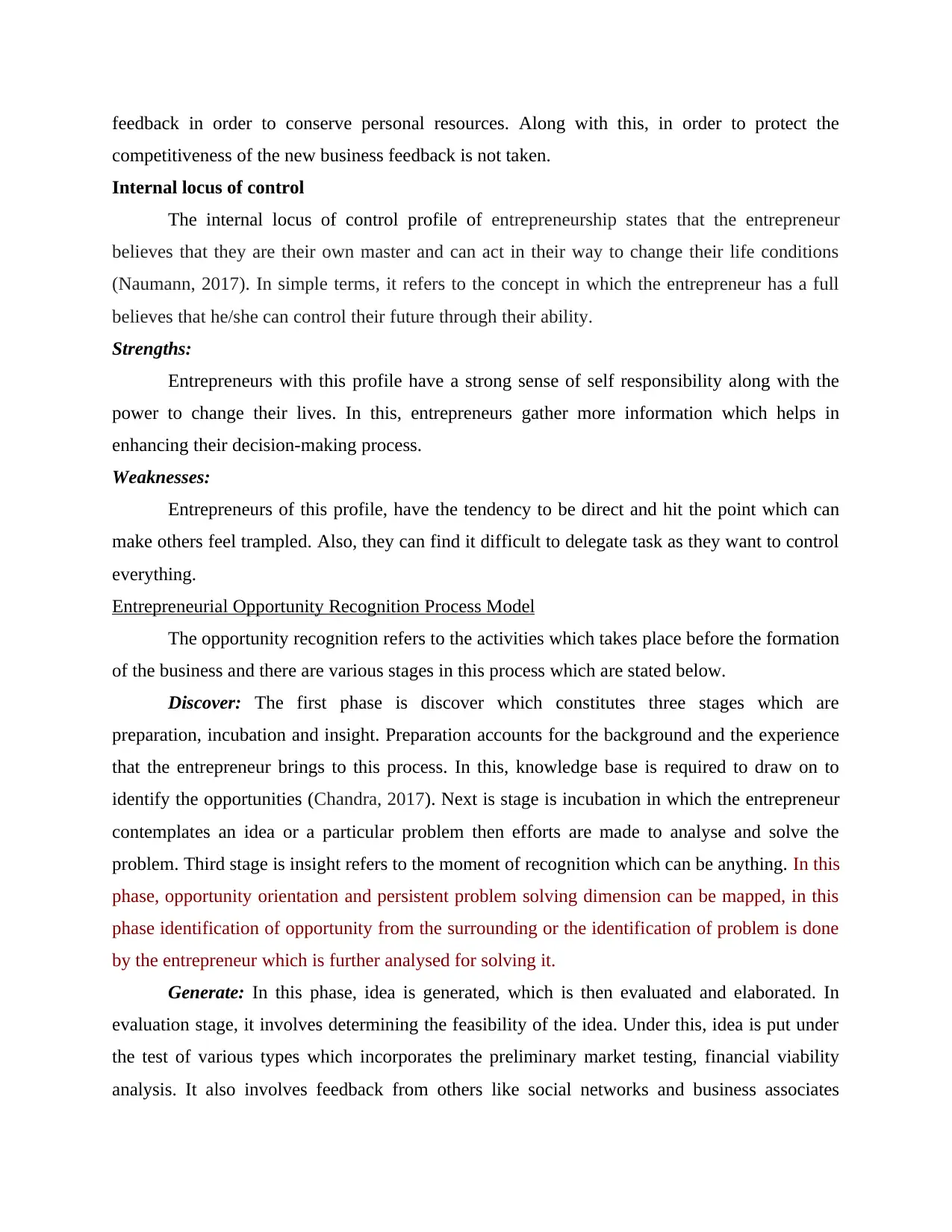
feedback in order to conserve personal resources. Along with this, in order to protect the
competitiveness of the new business feedback is not taken.
Internal locus of control
The internal locus of control profile of entrepreneurship states that the entrepreneur
believes that they are their own master and can act in their way to change their life conditions
(Naumann, 2017). In simple terms, it refers to the concept in which the entrepreneur has a full
believes that he/she can control their future through their ability.
Strengths:
Entrepreneurs with this profile have a strong sense of self responsibility along with the
power to change their lives. In this, entrepreneurs gather more information which helps in
enhancing their decision-making process.
Weaknesses:
Entrepreneurs of this profile, have the tendency to be direct and hit the point which can
make others feel trampled. Also, they can find it difficult to delegate task as they want to control
everything.
Entrepreneurial Opportunity Recognition Process Model
The opportunity recognition refers to the activities which takes place before the formation
of the business and there are various stages in this process which are stated below.
Discover: The first phase is discover which constitutes three stages which are
preparation, incubation and insight. Preparation accounts for the background and the experience
that the entrepreneur brings to this process. In this, knowledge base is required to draw on to
identify the opportunities (Chandra, 2017). Next is stage is incubation in which the entrepreneur
contemplates an idea or a particular problem then efforts are made to analyse and solve the
problem. Third stage is insight refers to the moment of recognition which can be anything. In this
phase, opportunity orientation and persistent problem solving dimension can be mapped, in this
phase identification of opportunity from the surrounding or the identification of problem is done
by the entrepreneur which is further analysed for solving it.
Generate: In this phase, idea is generated, which is then evaluated and elaborated. In
evaluation stage, it involves determining the feasibility of the idea. Under this, idea is put under
the test of various types which incorporates the preliminary market testing, financial viability
analysis. It also involves feedback from others like social networks and business associates
competitiveness of the new business feedback is not taken.
Internal locus of control
The internal locus of control profile of entrepreneurship states that the entrepreneur
believes that they are their own master and can act in their way to change their life conditions
(Naumann, 2017). In simple terms, it refers to the concept in which the entrepreneur has a full
believes that he/she can control their future through their ability.
Strengths:
Entrepreneurs with this profile have a strong sense of self responsibility along with the
power to change their lives. In this, entrepreneurs gather more information which helps in
enhancing their decision-making process.
Weaknesses:
Entrepreneurs of this profile, have the tendency to be direct and hit the point which can
make others feel trampled. Also, they can find it difficult to delegate task as they want to control
everything.
Entrepreneurial Opportunity Recognition Process Model
The opportunity recognition refers to the activities which takes place before the formation
of the business and there are various stages in this process which are stated below.
Discover: The first phase is discover which constitutes three stages which are
preparation, incubation and insight. Preparation accounts for the background and the experience
that the entrepreneur brings to this process. In this, knowledge base is required to draw on to
identify the opportunities (Chandra, 2017). Next is stage is incubation in which the entrepreneur
contemplates an idea or a particular problem then efforts are made to analyse and solve the
problem. Third stage is insight refers to the moment of recognition which can be anything. In this
phase, opportunity orientation and persistent problem solving dimension can be mapped, in this
phase identification of opportunity from the surrounding or the identification of problem is done
by the entrepreneur which is further analysed for solving it.
Generate: In this phase, idea is generated, which is then evaluated and elaborated. In
evaluation stage, it involves determining the feasibility of the idea. Under this, idea is put under
the test of various types which incorporates the preliminary market testing, financial viability
analysis. It also involves feedback from others like social networks and business associates
⊘ This is a preview!⊘
Do you want full access?
Subscribe today to unlock all pages.

Trusted by 1+ million students worldwide
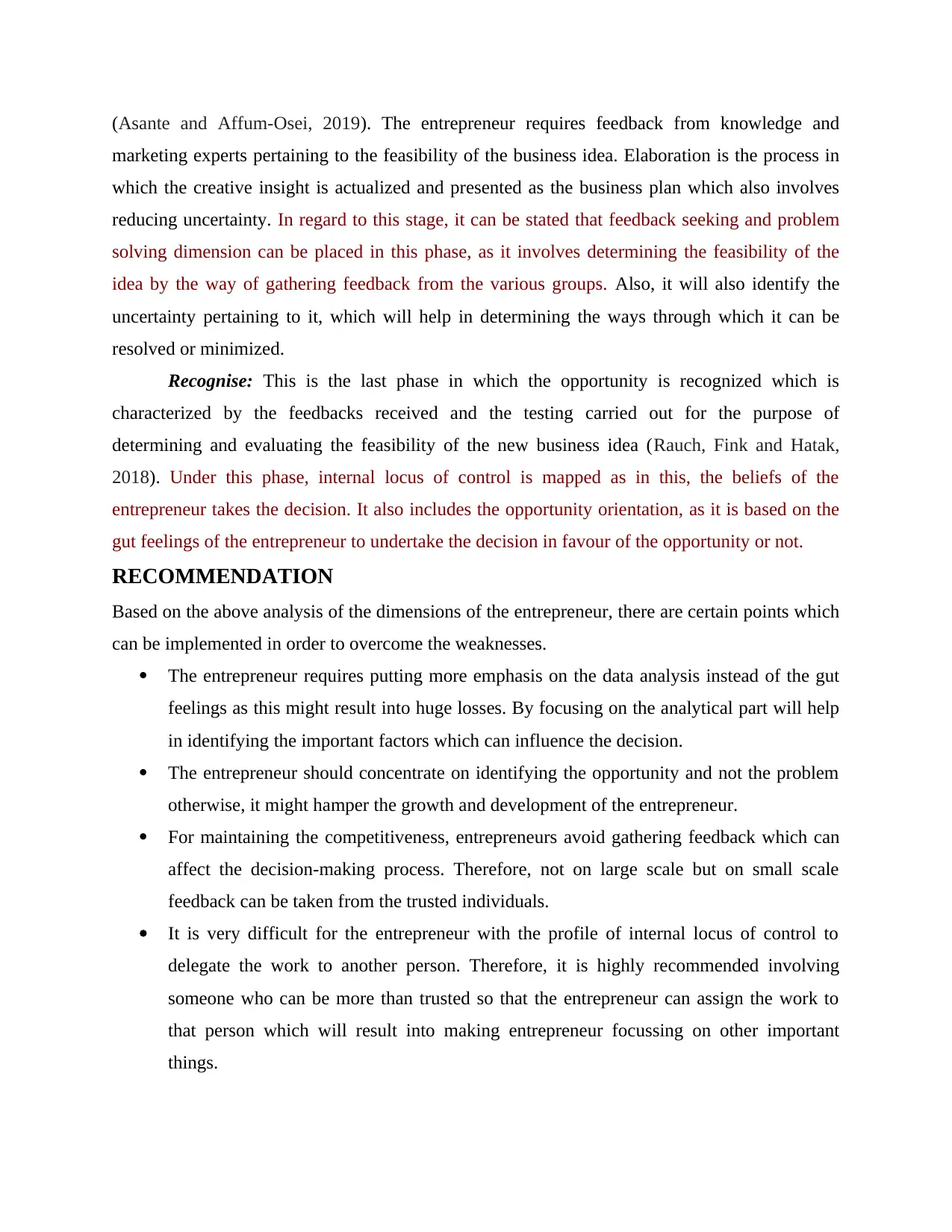
(Asante and Affum-Osei, 2019). The entrepreneur requires feedback from knowledge and
marketing experts pertaining to the feasibility of the business idea. Elaboration is the process in
which the creative insight is actualized and presented as the business plan which also involves
reducing uncertainty. In regard to this stage, it can be stated that feedback seeking and problem
solving dimension can be placed in this phase, as it involves determining the feasibility of the
idea by the way of gathering feedback from the various groups. Also, it will also identify the
uncertainty pertaining to it, which will help in determining the ways through which it can be
resolved or minimized.
Recognise: This is the last phase in which the opportunity is recognized which is
characterized by the feedbacks received and the testing carried out for the purpose of
determining and evaluating the feasibility of the new business idea (Rauch, Fink and Hatak,
2018). Under this phase, internal locus of control is mapped as in this, the beliefs of the
entrepreneur takes the decision. It also includes the opportunity orientation, as it is based on the
gut feelings of the entrepreneur to undertake the decision in favour of the opportunity or not.
RECOMMENDATION
Based on the above analysis of the dimensions of the entrepreneur, there are certain points which
can be implemented in order to overcome the weaknesses.
The entrepreneur requires putting more emphasis on the data analysis instead of the gut
feelings as this might result into huge losses. By focusing on the analytical part will help
in identifying the important factors which can influence the decision.
The entrepreneur should concentrate on identifying the opportunity and not the problem
otherwise, it might hamper the growth and development of the entrepreneur.
For maintaining the competitiveness, entrepreneurs avoid gathering feedback which can
affect the decision-making process. Therefore, not on large scale but on small scale
feedback can be taken from the trusted individuals.
It is very difficult for the entrepreneur with the profile of internal locus of control to
delegate the work to another person. Therefore, it is highly recommended involving
someone who can be more than trusted so that the entrepreneur can assign the work to
that person which will result into making entrepreneur focussing on other important
things.
marketing experts pertaining to the feasibility of the business idea. Elaboration is the process in
which the creative insight is actualized and presented as the business plan which also involves
reducing uncertainty. In regard to this stage, it can be stated that feedback seeking and problem
solving dimension can be placed in this phase, as it involves determining the feasibility of the
idea by the way of gathering feedback from the various groups. Also, it will also identify the
uncertainty pertaining to it, which will help in determining the ways through which it can be
resolved or minimized.
Recognise: This is the last phase in which the opportunity is recognized which is
characterized by the feedbacks received and the testing carried out for the purpose of
determining and evaluating the feasibility of the new business idea (Rauch, Fink and Hatak,
2018). Under this phase, internal locus of control is mapped as in this, the beliefs of the
entrepreneur takes the decision. It also includes the opportunity orientation, as it is based on the
gut feelings of the entrepreneur to undertake the decision in favour of the opportunity or not.
RECOMMENDATION
Based on the above analysis of the dimensions of the entrepreneur, there are certain points which
can be implemented in order to overcome the weaknesses.
The entrepreneur requires putting more emphasis on the data analysis instead of the gut
feelings as this might result into huge losses. By focusing on the analytical part will help
in identifying the important factors which can influence the decision.
The entrepreneur should concentrate on identifying the opportunity and not the problem
otherwise, it might hamper the growth and development of the entrepreneur.
For maintaining the competitiveness, entrepreneurs avoid gathering feedback which can
affect the decision-making process. Therefore, not on large scale but on small scale
feedback can be taken from the trusted individuals.
It is very difficult for the entrepreneur with the profile of internal locus of control to
delegate the work to another person. Therefore, it is highly recommended involving
someone who can be more than trusted so that the entrepreneur can assign the work to
that person which will result into making entrepreneur focussing on other important
things.
Paraphrase This Document
Need a fresh take? Get an instant paraphrase of this document with our AI Paraphraser
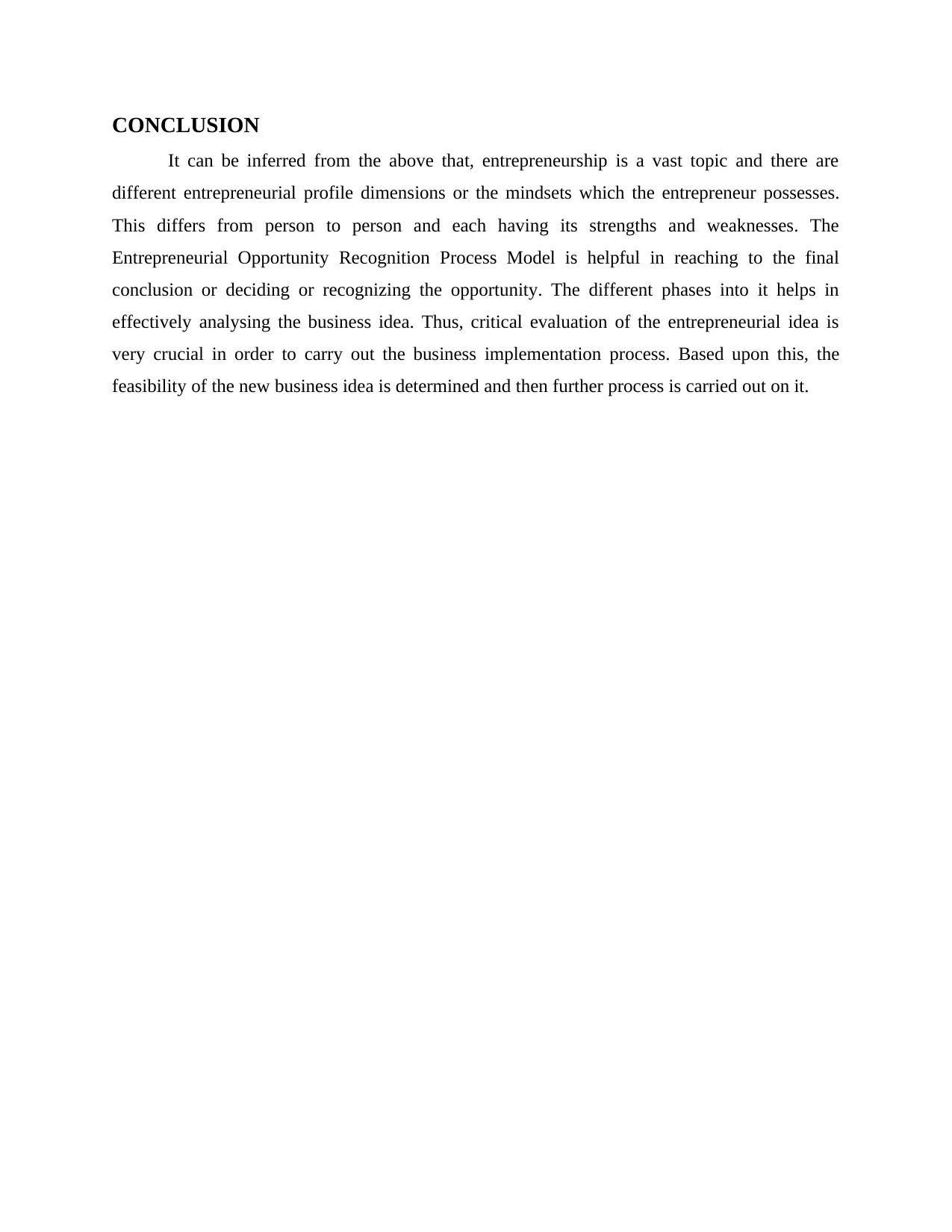
CONCLUSION
It can be inferred from the above that, entrepreneurship is a vast topic and there are
different entrepreneurial profile dimensions or the mindsets which the entrepreneur possesses.
This differs from person to person and each having its strengths and weaknesses. The
Entrepreneurial Opportunity Recognition Process Model is helpful in reaching to the final
conclusion or deciding or recognizing the opportunity. The different phases into it helps in
effectively analysing the business idea. Thus, critical evaluation of the entrepreneurial idea is
very crucial in order to carry out the business implementation process. Based upon this, the
feasibility of the new business idea is determined and then further process is carried out on it.
It can be inferred from the above that, entrepreneurship is a vast topic and there are
different entrepreneurial profile dimensions or the mindsets which the entrepreneur possesses.
This differs from person to person and each having its strengths and weaknesses. The
Entrepreneurial Opportunity Recognition Process Model is helpful in reaching to the final
conclusion or deciding or recognizing the opportunity. The different phases into it helps in
effectively analysing the business idea. Thus, critical evaluation of the entrepreneurial idea is
very crucial in order to carry out the business implementation process. Based upon this, the
feasibility of the new business idea is determined and then further process is carried out on it.
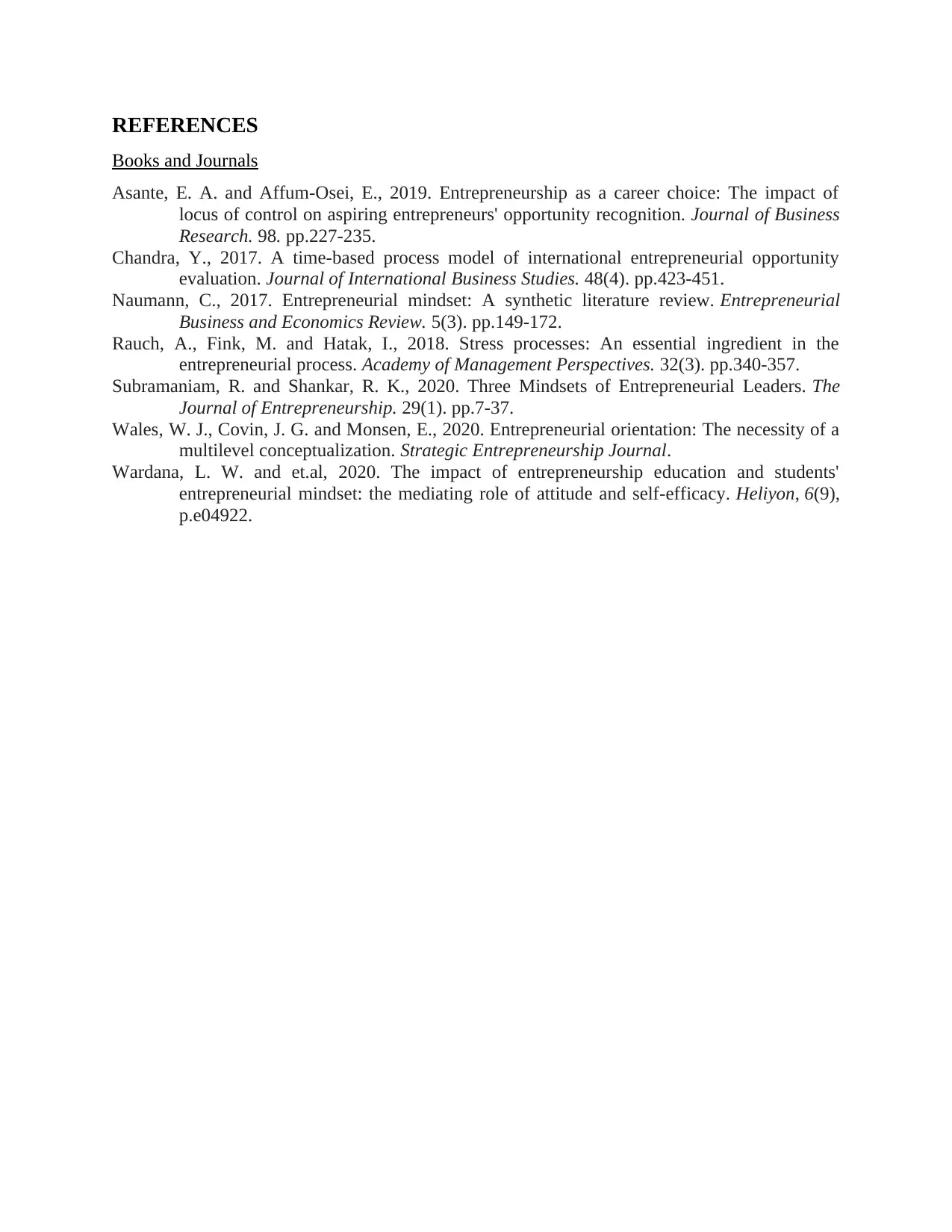
REFERENCES
Books and Journals
Asante, E. A. and Affum-Osei, E., 2019. Entrepreneurship as a career choice: The impact of
locus of control on aspiring entrepreneurs' opportunity recognition. Journal of Business
Research. 98. pp.227-235.
Chandra, Y., 2017. A time-based process model of international entrepreneurial opportunity
evaluation. Journal of International Business Studies. 48(4). pp.423-451.
Naumann, C., 2017. Entrepreneurial mindset: A synthetic literature review. Entrepreneurial
Business and Economics Review. 5(3). pp.149-172.
Rauch, A., Fink, M. and Hatak, I., 2018. Stress processes: An essential ingredient in the
entrepreneurial process. Academy of Management Perspectives. 32(3). pp.340-357.
Subramaniam, R. and Shankar, R. K., 2020. Three Mindsets of Entrepreneurial Leaders. The
Journal of Entrepreneurship. 29(1). pp.7-37.
Wales, W. J., Covin, J. G. and Monsen, E., 2020. Entrepreneurial orientation: The necessity of a
multilevel conceptualization. Strategic Entrepreneurship Journal.
Wardana, L. W. and et.al, 2020. The impact of entrepreneurship education and students'
entrepreneurial mindset: the mediating role of attitude and self-efficacy. Heliyon, 6(9),
p.e04922.
Books and Journals
Asante, E. A. and Affum-Osei, E., 2019. Entrepreneurship as a career choice: The impact of
locus of control on aspiring entrepreneurs' opportunity recognition. Journal of Business
Research. 98. pp.227-235.
Chandra, Y., 2017. A time-based process model of international entrepreneurial opportunity
evaluation. Journal of International Business Studies. 48(4). pp.423-451.
Naumann, C., 2017. Entrepreneurial mindset: A synthetic literature review. Entrepreneurial
Business and Economics Review. 5(3). pp.149-172.
Rauch, A., Fink, M. and Hatak, I., 2018. Stress processes: An essential ingredient in the
entrepreneurial process. Academy of Management Perspectives. 32(3). pp.340-357.
Subramaniam, R. and Shankar, R. K., 2020. Three Mindsets of Entrepreneurial Leaders. The
Journal of Entrepreneurship. 29(1). pp.7-37.
Wales, W. J., Covin, J. G. and Monsen, E., 2020. Entrepreneurial orientation: The necessity of a
multilevel conceptualization. Strategic Entrepreneurship Journal.
Wardana, L. W. and et.al, 2020. The impact of entrepreneurship education and students'
entrepreneurial mindset: the mediating role of attitude and self-efficacy. Heliyon, 6(9),
p.e04922.
⊘ This is a preview!⊘
Do you want full access?
Subscribe today to unlock all pages.

Trusted by 1+ million students worldwide
1 out of 9
Related Documents
Your All-in-One AI-Powered Toolkit for Academic Success.
+13062052269
info@desklib.com
Available 24*7 on WhatsApp / Email
![[object Object]](/_next/static/media/star-bottom.7253800d.svg)
Unlock your academic potential
Copyright © 2020–2025 A2Z Services. All Rights Reserved. Developed and managed by ZUCOL.



